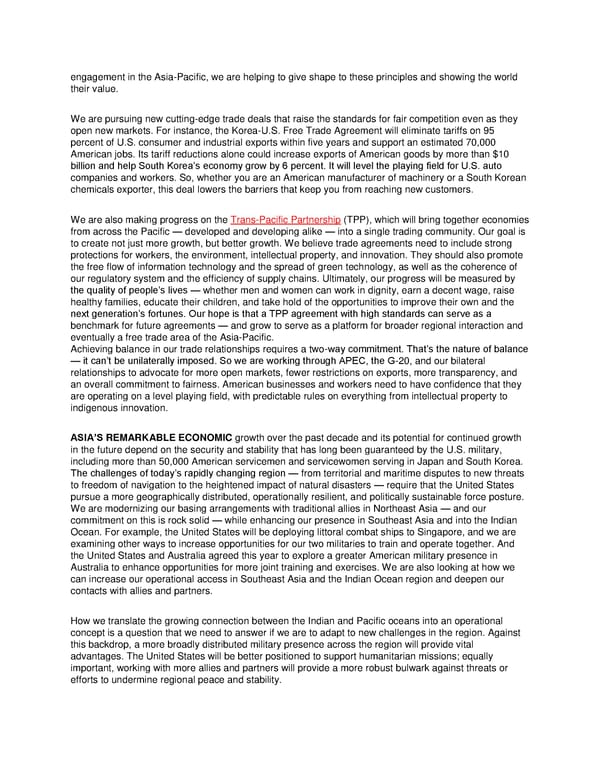engagement in the Asia-Pacific, we are helping to give shape to these principles and showing the world their value. We are pursuing new cutting-edge trade deals that raise the standards for fair competition even as they open new markets. For instance, the Korea-U.S. Free Trade Agreement will eliminate tariffs on 95 percent of U.S. consumer and industrial exports within five years and support an estimated 70,000 American jobs. Its tariff reductions alone could increase exports of American goods by more than $10 billion and help South Korea’s economy grow by 6 percent. It will level the playing field for U.S. auto companies and workers. So, whether you are an American manufacturer of machinery or a South Korean chemicals exporter, this deal lowers the barriers that keep you from reaching new customers. We are also making progress on the Trans-Pacific Partnership (TPP), which will bring together economies from across the Pacific — developed and developing alike — into a single trading community. Our goal is to create not just more growth, but better growth. We believe trade agreements need to include strong protections for workers, the environment, intellectual property, and innovation. They should also promote the free flow of information technology and the spread of green technology, as well as the coherence of our regulatory system and the efficiency of supply chains. Ultimately, our progress will be measured by the quality of people’s lives — whether men and women can work in dignity, earn a decent wage, raise healthy families, educate their children, and take hold of the opportunities to improve their own and the next generation’s fortunes. Our hope is that a TPP agreement with high standards can serve as a benchmark for future agreements — and grow to serve as a platform for broader regional interaction and eventually a free trade area of the Asia-Pacific. Achieving balance in our trade relationships requires a two-way commitment. That’s the nature of balance — it can’t be unilaterally imposed. So we are working through APEC, the G-20, and our bilateral relationships to advocate for more open markets, fewer restrictions on exports, more transparency, and an overall commitment to fairness. American businesses and workers need to have confidence that they are operating on a level playing field, with predictable rules on everything from intellectual property to indigenous innovation. ASIA’S REMARKABLE ECONOMIC growth over the past decade and its potential for continued growth in the future depend on the security and stability that has long been guaranteed by the U.S. military, including more than 50,000 American servicemen and servicewomen serving in Japan and South Korea. The challenges of today’s rapidly changing region — from territorial and maritime disputes to new threats to freedom of navigation to the heightened impact of natural disasters — require that the United States pursue a more geographically distributed, operationally resilient, and politically sustainable force posture. We are modernizing our basing arrangements with traditional allies in Northeast Asia — and our commitment on this is rock solid — while enhancing our presence in Southeast Asia and into the Indian Ocean. For example, the United States will be deploying littoral combat ships to Singapore, and we are examining other ways to increase opportunities for our two militaries to train and operate together. And the United States and Australia agreed this year to explore a greater American military presence in Australia to enhance opportunities for more joint training and exercises. We are also looking at how we can increase our operational access in Southeast Asia and the Indian Ocean region and deepen our contacts with allies and partners. How we translate the growing connection between the Indian and Pacific oceans into an operational concept is a question that we need to answer if we are to adapt to new challenges in the region. Against this backdrop, a more broadly distributed military presence across the region will provide vital advantages. The United States will be better positioned to support humanitarian missions; equally important, working with more allies and partners will provide a more robust bulwark against threats or efforts to undermine regional peace and stability.
 HRC America's Pacific Century Page 6 Page 8
HRC America's Pacific Century Page 6 Page 8